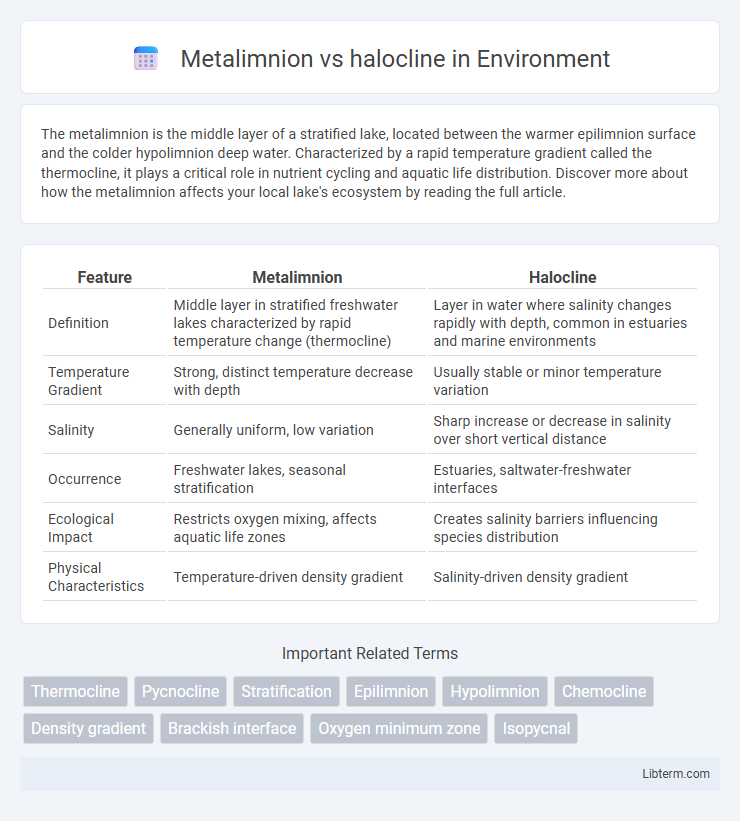The metalimnion is the middle layer of a stratified lake, located between the warmer epilimnion surface and the colder hypolimnion deep water. Characterized by a rapid temperature gradient called the thermocline, it plays a critical role in nutrient cycling and aquatic life distribution. Discover more about how the metalimnion affects your local lake's ecosystem by reading the full article.
Table of Comparison
| Feature | Metalimnion | Halocline |
|---|---|---|
| Definition | Middle layer in stratified freshwater lakes characterized by rapid temperature change (thermocline) | Layer in water where salinity changes rapidly with depth, common in estuaries and marine environments |
| Temperature Gradient | Strong, distinct temperature decrease with depth | Usually stable or minor temperature variation |
| Salinity | Generally uniform, low variation | Sharp increase or decrease in salinity over short vertical distance |
| Occurrence | Freshwater lakes, seasonal stratification | Estuaries, saltwater-freshwater interfaces |
| Ecological Impact | Restricts oxygen mixing, affects aquatic life zones | Creates salinity barriers influencing species distribution |
| Physical Characteristics | Temperature-driven density gradient | Salinity-driven density gradient |
Defining Metalimnion and Halocline
The metalimnion is the middle layer in a thermally stratified lake, characterized by a rapid temperature gradient between the warmer epilimnion above and the colder hypolimnion below. The halocline is a layer in a body of water where salinity changes sharply with depth, typically found in estuaries or saline lakes. Both layers serve as transitional zones but differ fundamentally in the physical property they stratify--temperature for the metalimnion and salinity for the halocline.
Physical Characteristics Comparison
The metalimnion, also known as the thermocline, is a distinct layer in a stratified lake where temperature changes rapidly with depth, creating a sharp thermal gradient between the warmer epilimnion above and the colder hypolimnion below. The halocline is a similar stratified layer found in marine or estuarine environments characterized by a sudden increase in salinity with depth, separating fresher surface water from saltier deeper water. While the metalimnion is primarily defined by temperature differences influencing water density and mixing, the halocline's physical characteristic is salinity variation, which similarly affects water density and stratification.
Formation Processes: Metalimnion vs Halocline
The metalimnion forms as a distinct thermocline layer in stratified lakes where temperature rapidly decreases with depth due to solar heating and seasonal mixing patterns. The halocline develops in estuarine or marine environments where salinity gradients arise from the mixing of freshwater and seawater, creating a sharp salinity transition zone. Both layers act as physical barriers in aquatic systems but result from temperature-driven density changes for the metalimnion and salinity-driven density differences for the halocline.
Temperature and Salinity Gradients
The metalimnion is characterized by a rapid temperature gradient known as the thermocline, where water temperature decreases sharply with depth, typically found in freshwater lakes. In contrast, the halocline exhibits a pronounced salinity gradient, with salinity levels increasing significantly over a short vertical distance, commonly occurring in estuarine or marine environments. While the metalimnion primarily affects thermal stratification, the halocline influences density stratification due to varying salt concentrations.
Role in Aquatic Stratification
The metalimnion plays a critical role in thermal stratification by forming a distinct layer with rapid temperature changes, typically between the warmer epilimnion and cooler hypolimnion in lakes and reservoirs. The halocline creates a salinity gradient layer that influences density stratification in estuaries and marine environments, limiting vertical mixing and affecting nutrient and oxygen distribution. Both layers regulate aquatic ecosystem dynamics by controlling stratification intensity, mixing processes, and habitat differentiation for aquatic organisms.
Ecological Significance and Impact on Biodiversity
The metalimnion, a thermally stratified layer in lakes, creates distinct temperature gradients that influence oxygen distribution and nutrient cycling, fostering diverse aquatic habitats. The halocline, a salinity gradient often found in estuaries or saltwater lakes, impacts species composition by separating freshwater and saltwater species, thus shaping unique ecological niches. Both layers play crucial roles in maintaining biodiversity by supporting specialized organisms adapted to specific thermal or salinity conditions.
Occurrence in Freshwater vs Marine Environments
The metalimnion primarily occurs in freshwater lakes, representing the temperature gradient layer between the warm epilimnion and cold hypolimnion during thermal stratification. The halocline is found mainly in marine environments, where it marks the rapid salinity gradient separating surface freshwater or brackish water from deeper saline water. Both layers play critical roles in water column stability and nutrient cycling within their respective aquatic systems.
Influencing Factors: Climate and Geography
Climate and geography significantly influence the formation of the metalimnion and halocline in aquatic environments. The metalimnion, a thermocline layer characterized by a rapid temperature gradient, develops primarily in lakes with seasonal temperature fluctuations driven by latitude and altitude. Conversely, haloclines form in estuaries and coastal zones where freshwater and seawater mix, with salinity gradients shaped by regional precipitation, freshwater inflow, and oceanographic conditions influenced by geographic features such as river discharge and basin morphology.
Implications for Water Mixing and Circulation
The metalimnion, characterized by a steep temperature gradient in a stratified lake, significantly influences water mixing by creating a thermal barrier that limits vertical circulation and nutrient exchange between the epilimnion and hypolimnion. In contrast, the halocline, marked by a sharp salinity gradient commonly found in estuarine and marine environments, restricts mixing due to density differences caused by salt concentration variations, affecting water column stability and salinity-driven currents. Both layers impact aquatic ecosystems by controlling oxygen distribution, nutrient cycling, and the movement of organisms, ultimately shaping aquatic habitat conditions and biogeochemical processes.
Applications in Limnology and Oceanography
The metalimnion, a thermally stratified water layer found in lakes, plays a crucial role in limnology by influencing oxygen distribution and nutrient cycling, thereby affecting aquatic ecosystems and fish habitats. In oceanography, the halocline represents a distinct salinity gradient essential for studying oceanic circulation, water mass formation, and mixing processes that impact global climate patterns. Both the metalimnion and halocline serve as key indicators in monitoring environmental changes and managing freshwater and marine resources effectively.
Metalimnion Infographic

 libterm.com
libterm.com